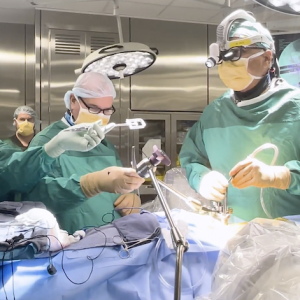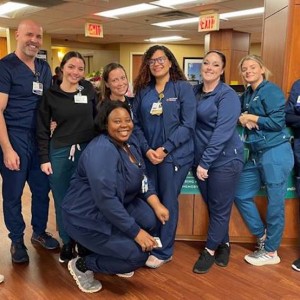SMH Unveils da Vinci Robotic Surgery System
Todays News
SRQ DAILY FRESHLY SQUEEZED CONTENT EVERY MORNING
WEDNESDAY NOV 19, 2014 |
BY BEN REECE
Watching an accomplished surgeon work the arms and pedals of the da Vinci robotic-assisted surgical system is like watching a master organist perform: his hands and feet move with confidence, and man and machine seem as one. Actually using the da Vinci demonstrates why. The display is like looking down onto the operating table with eyes that can zoom into an 8-millimeter hole, and the manipulating arms have over six joints with at least 180 degrees of movement. When all this comes together as neatly as it does, using the system becomes intuitive—the robot almost responds to thoughts, becoming an extension of the hands.
Dr. James Fiorica, the chief of staff at SMH, as well as the head of Gynecological Oncology, medical director of Robotic Surgery and chairman of the Robotic Steering Committee, described the da Vinci system and how it was used in procedures. A particularly important step in bridging the disconnect between surgeon and robot was made with the improvement to the da Vinci’s binary camera system, which is what allows the display to more closely mimic human vision by showing depth of field. This feature, coupled with the camera’s ability to adjust magnification, means an operating surgeon can see with 15 times the visual acuity of the unaided eye.
Fiorica emphasized the robot was only an assisting device: “It’s not the robot doing the surgery. It’s the surgeon and his team doing the surgery.” Patients are encouraged to go online to the SMH website to see the da Vinci system for themselves, so they know what to expect when they get to the operating room.
SMH made another recent important acquisition in the form of Dr. Kenneth Meredith. He is the No. 1 physician in the world for esophageal cancer surgeries, and is also in the top five robot-assisted pancreatic cancer surgeons in the country, having begun his involvement with robotic surgical systems in 2002.
Meredith described how the da Vinci system makes surgery safer and a better overall experience for both patient and physician. Surgeries that would normally require the entire torso to be opened, such as operations on endometrial or uterine cancers, require only a two-inch incision to complete with the da Vinci system.
There is a much better recovery period for patients when robotic surgery systems are used; 95 percent of Meredith’s endometrial cancer robotic surgery patients are home the day after the surgery. In light of both the smaller incision and drastically reduced recovery period, Meredith said that physicians across the world were “obligated as surgeons” to offer the robotic surgery.
« View The Wednesday Nov 19, 2014 SRQ Daily Edition
« Back To SRQ Daily Archive











